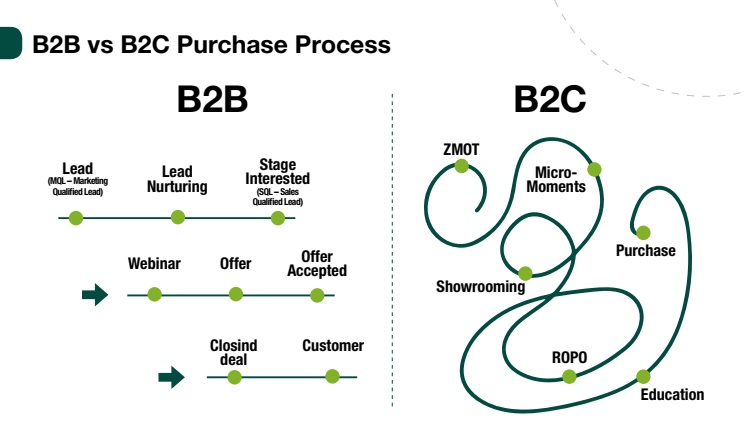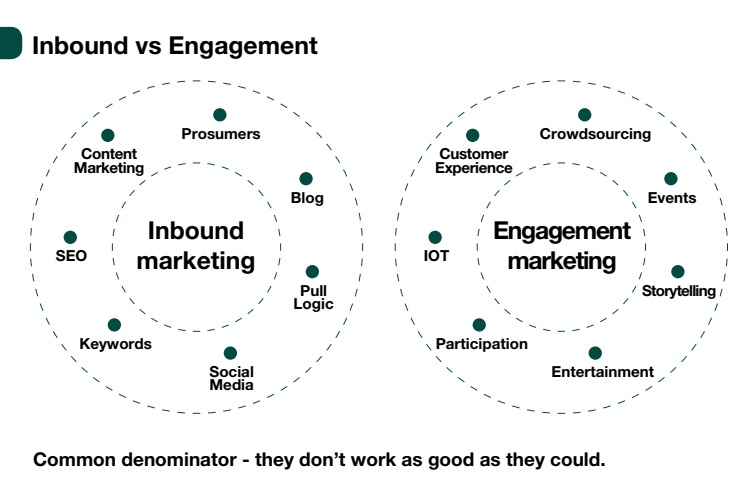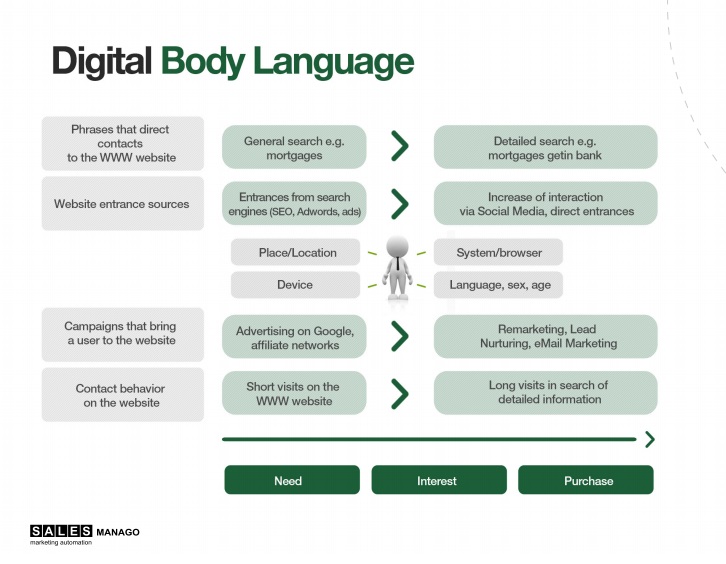“More and more B2C marketers are adopting B2B strategies?” – sorry guys – it’s BS.
We understand that they faced the huge increase of B2C companies and Online stores entering marketing automation, but selling them the same software as for B2B and explaining with analysts that they should adopt B2B strategies is not good.

You probably have heard of the widely repeated phrase which goes like this: “More and more B2C marketers are adopting B2B strategies”. A few years ago it was developed by the leading marketing automation research analysts and then promoted by all the major providers of marketing automation tools in the US. Today, after 5 years of delivering marketing automation platform to over 6000 Online Stores and B2C companies worldwide, I may clearly say: this approach is just totally wrong.
Greg Blazewicz,
Founder & CEO of SALESmanago Marketing Automation
Inbound vs Engagement
Engagement and Inbound stuff is a way to make delivering more value to the company sound very sexy, but…
…at the end of the day the sexiest thing that marketers can think of is money they are managing and bringing to the company.

That’s why, as a result of 5 years of experience of providing marketing technology for Online stores and B2C companies, we would like to introduce our own approach to building marketing automation strategy. We call it Customer Value Marketing, and we hope that you marketers will find this approach interesting and worth spending some time on it. We have also prepared a complete set of special features at our SALESmanago platform that fully support this idea and enable implementation of the new marketing processes.
Greg Blazewicz,
Founder & CEO of SALESmanago
Customer Value Marketing – the real challenge is to increase the customer value over time
Customer Value Marketing is a marketing strategy designed for B2C marketers built around the concept of customer value and marketing automation. Customer Value Marketing aims at building the highest value of a customer over time.
Customer Value Marketing is redefining traditional outbound marketing by the deployment of advanced methods of dynamic customer segmentation based on RFM (Recency, Frequency, Monetary) analytics, supported by behavioral (Digital Body Language) analytics used to create real-time multichannel structure of marketing automation processes along the whole customer lifecycle, from lead generation to bringing customer to most valuable segment and fostering long-term relationships.
Customer Value Marketing uses traditional outbound channels like email, website, online advertising, telemarketing as well as social media and mobile channel to create non-linear processes (as opposed to the linear processes present in the B2B context) of personalized, real-time offer delivery to the right person at the right time.
Customer Value Marketing is marketing strategy standing in contradiction to inbound marketing, as designed for B2B marketers and primarily oriented on generating leads and serving to attract and educate customers through different stages of the purchase funnel and driving website traffic by means of creating interesting content.
The main marketing technique to achieve the results of Customer Value Marketing is RFM based Marketing Automation based on dynamic segmentation of customers depending on the transactional activity of customer over time supported by the behavioral data gathered about the single customer in marketing automation platform. This new, dynamic, RFM based 360 Degrees Customer View may be then used to create a totally new structure of marketing automation processes using email, dynamic website content, mobile, social
media, advertising networks, POS and direct sales to migrate the customer to the highest value segments of customers.
RFM
RFM based Marketing Automation feature segments customers according to purchases and transactions made by them. Transaction Analysis and segmentation goes beyond the value of the purchase and takes into account two additional dimensions: the frequency and the time elapsed since the last purchase. Those automatically created segments can then be used for implementation of:
- one-off marketing campaigns, such as sending emails, text messages, or the implementation of targeted advertising campaigns,
- creating a completely new, non-linear model of automation rules, which aim to automatically migrate customers from the less valuable to most valuable customer segments.
Advanced segmentation of customers
RFM is a module which enables to analyze purchasing behaviors, segment customers and automate marketing and sales processes based on transactional data. It analyzes every customer in terms of three basic information:
- Recency – shows when was the last time a customer made a purchase order in the following dimensions: long, medium, short.
- Frequency – shows how regularly does this customer make a purchase in the following dimensions: regular, casual, often.
- Monetary (the purchase value) – shows how much money does this customer spend over a given period in the following dimensions:
spender, average, saver.
Recency
RFM analytical dashboard presents information about clients recent activity in time segment, thereby dividing users who bought within a period of time that was either:
- short
- medium
- long
By analyzing this data, we can compare the number of recently purchased products to the number of purchased products in the past by
customers. We can also notice the difference between the revenue and the number of transactions made, and estimate the exact time in which we achieved the highest profit.
Frequency
Analytical dashboard shows clients in terms of their frequency of buying new products in time segments, thereby dividing them into customers who buy:
- casually
- regularly
- long
The analysis of this data allows you to compare the number of transactions made by the particular contact groups and the number of clients in segments, and thus showing us the characters, preferences and trends in various contact groups, depending on the frequency of performed transactions.
Monetary
Analytical dashboard presents the number of clients in terms of how much money they spend on our products in time segments, thereby distinguishing them as a:
- saver
- average
- spender
This analysis enables us to determine the character of particular customer groups, compare the frequency and the number of transactions made by particular consumers’ segments, so you can create even better- personalized offer based on cross-selling and up-selling strategies.
Analytical dashboard RFM
Analytical dashboard RFM allows us to correlate two variables, which show purchase preferences and trends of customers.
These variables comparison results in detailed information about customers including:
- recency and frequency,
- frequency and monetary value,
- recency and monetary value.

Automation
Automation of marketing processes allows for responding to both: desirable and negative contact behavior automatically, in real time, thus one can run a complete range of marketing processes:
- one-off marketing campaigns, such as sending emails, text messages, or the implementation of targeted advertising campaigns,
- creating a completely new, non-linear model of automation rules, which aim to automatically migrate customers from the less valuable to most valuable customer segments.
Benefits of switching from the traditional marketing to the new Customer Value approach:
- Aims at building the highest value of a customer over time.
- Redefines traditional outbound marketing by the deployment of advanced methods of dynamic customer segmentation based on RFM analytics, supported by behavioral analytics.
- Helps to create real-time multichannel structure of marketing automation processes along the whole customer lifecycle, from lead generation to bringing customer to most valuable segment and fostering long-term relationships.
- Uses traditional outbound channels to create non-linear processes of personalized, real-time offer delivery to the right person at the right time.
- Creates a totally new structure of marketing automation processes to bring the customer to the highest value segments of consumers.
 Follow
Follow
















